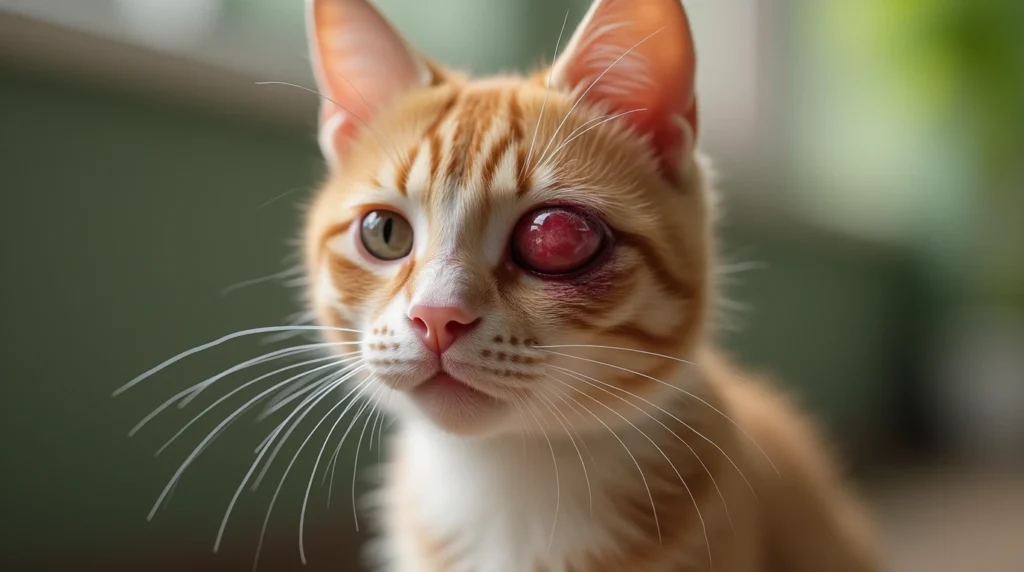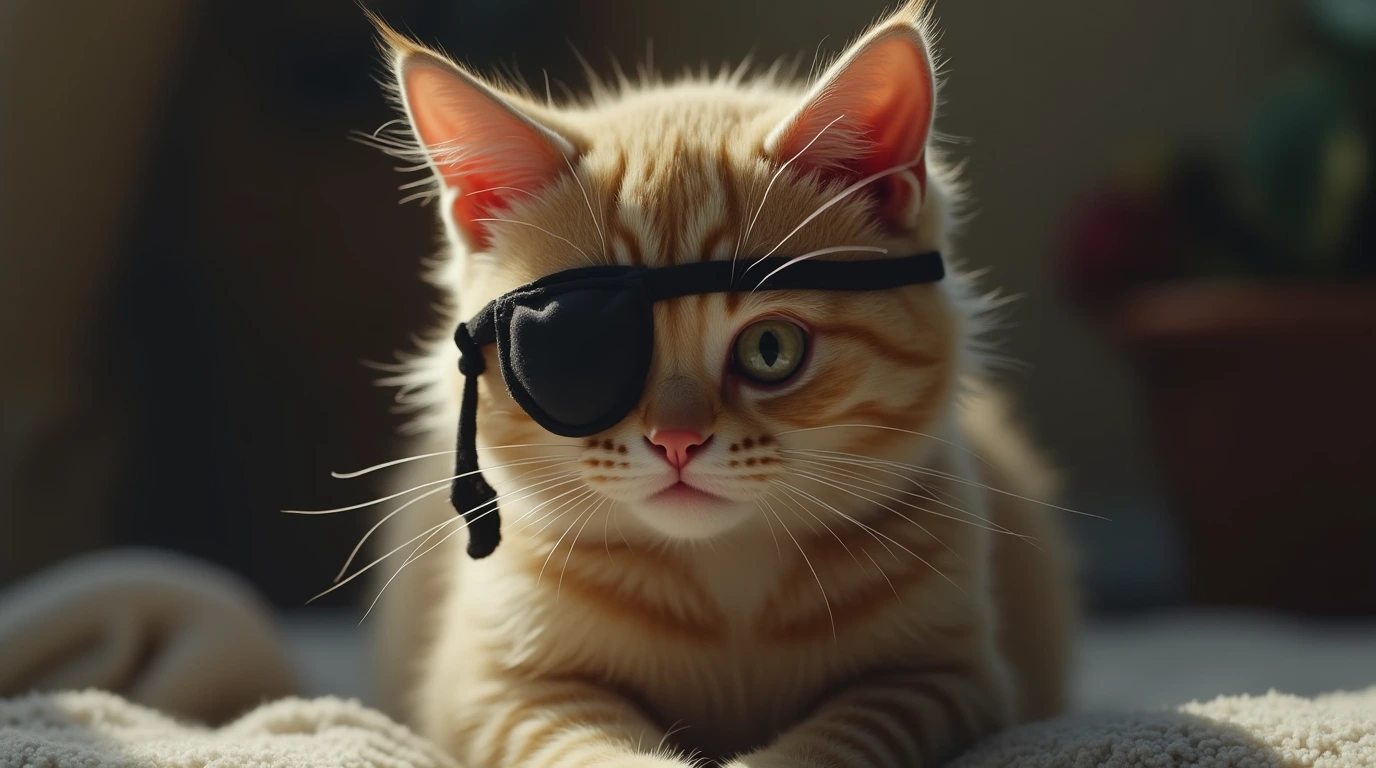As a pet parent, there are moments when you glance at your cat and notice something seems off. One of the most alarming things to spot is a swollen eye. Whether it’s a minor issue or a serious health concern, your cat’s well-being is your priority. In this article, we’ll dive into the potential causes of a swollen eye in cats, highlight the symptoms you should watch for, and outline treatment options that can help restore your cat’s eye health. If you’ve noticed swelling around your cat’s eye, read on to understand what might be happening and how you can help your furry friend recover.
Table of Contents
Understanding Cat Swollen Eyes: What Is It?
Before diving into the causes and treatment options, it’s crucial to first understand what we mean by a swollen eye in cats. A swollen eye can manifest in various ways, from mild puffiness to more pronounced swelling. You might notice that your cat’s eye appears enlarged or puffy, with redness around the eyelids or eyeball. In some cases, there could be clear, yellow, or green discharge, indicating irritation or infection. The severity of the swelling can vary—sometimes it’s minor and fades quickly, but other times it may be more serious, signaling a deeper issue that requires attention.
What Does a Swollen Eye Look Like?
When your cat’s eye becomes swollen, the first thing you might notice is puffiness or inflammation. The eye itself might be red, squinty, or have excessive tearing. There could be discharge as well, ranging from clear fluid to thicker, yellowish or green mucus. In some cases, the swelling is noticeable around the eyelid or under the eye, giving it a puffy appearance.
It’s important to assess your cat’s behavior too. A cat with a swollen eye might squint or paw at their eye to try and relieve the discomfort. If you notice any changes in your cat’s behavior, such as avoiding bright light or showing signs of irritation, it could be linked to the swollen eye.
Why It’s Important to Address It
Ignoring a swollen eye in your cat can lead to more serious complications. Swelling may be a sign of an underlying infection, injury, or even an eye disorder that, if left untreated, can worsen over time. Infections can spread, and untreated injuries can cause permanent damage or affect your cat’s vision. By addressing the issue early, you can prevent further harm and alleviate discomfort. Most eye conditions, when treated promptly, can be resolved without long-term effects, preserving both your cat’s eye health and overall well-being. Early intervention ensures a quicker recovery and minimizes the risk of complications.

Causes of a Swollen Eye in Cats
A swollen eye in cats can be caused by various factors. The most common reasons include infections, injuries, allergies, or underlying health conditions. Let’s explore the main causes of a swollen eye in more detail.
Infections
One of the most common reasons for a swollen eye in cats is an infection. These infections can be bacterial, viral, or fungal, with the most frequent culprits being conjunctivitis (an infection of the conjunctiva, or the thin tissue that covers the eye), upper respiratory infections, or more severe viral infections like feline herpesvirus.
Symptoms of an Eye Infection:
- Redness and swelling around the eye
- Excessive eye discharge (clear, yellow, or green)
- Squinting or keeping the eye closed
- Lethargy or loss of appetite
Treatment Options:
- Antibiotics or antiviral medications may be prescribed by your vet to target the specific infection.
- If the infection is viral, your vet might suggest topical treatments or support therapy to help manage symptoms.
Trauma or Injury
Cats are curious creatures, and their adventures often lead to injuries. A swollen eye could result from trauma, such as a scratch from another animal or an accidental bump during playtime. In more serious cases, a foreign object could get lodged in the eye.
Symptoms of Eye Injury:
- Visible swelling, bruising, or blood
- Your cat pawing at the eye or rubbing their face
- Discharge or tears
- Sensitivity to light
Treatment Options:
- If there’s an external injury, your vet will likely clean the area and apply antibiotic ointment to prevent infection.
- In more severe cases, surgery may be necessary to remove foreign bodies or to treat deeper injuries.
Allergies
Cats, like people, can suffer from allergies. These can be environmental (like pollen or dust mites), food-related, or caused by substances in their home (such as cleaning products or perfumes). Allergies can cause swelling and irritation in the eyes, leading to a condition called allergic conjunctivitis.
Symptoms of Allergies:
- Watery eyes
- Sneezing or coughing
- Itchy or red eyes
- Swelling of the eyelid
Treatment Options:
- Your vet may recommend antihistamines or a change in diet to manage food-related allergies.
- If the allergy is environmental, limiting exposure to allergens or using air purifiers in your home might help alleviate the issue.
Glaucoma or Other Eye Disorders
Sometimes, a swollen eye is a sign of an underlying eye disorder, such as glaucoma (increased pressure within the eye). Other conditions, like uveitis (inflammation of the eye), can also cause swelling.
Symptoms of Glaucoma or Eye Disorders:
- Cloudiness or redness in the eye
- Swelling that doesn’t improve over time
- Sensitivity to light
- Loss of vision or changes in pupil size
Treatment Options:
- In some cases, medication can help reduce intraocular pressure or treat inflammation.
- If the condition is advanced, surgery might be necessary to preserve vision.
Foreign Bodies in the Eye
If your cat spends time outdoors, they could encounter small foreign bodies like grass seeds, dust, or dirt that can become trapped in the eye. This can lead to irritation and swelling.
Symptoms of Foreign Bodies in the Eye:
- Excessive tearing or eye discharge
- Pawing at the eye or rubbing the face
- Sensitivity to light
Treatment Options:
- Your vet will carefully remove the foreign body from the eye and may prescribe eye drops to help with healing.
Recognizing the Symptoms of a Swollen Eye in Cats
While a swollen eye in cats is often accompanied by visible physical signs like redness or discharge, it’s equally important to observe changes in your cat’s behavior. Cats are known to hide their discomfort, making it harder to spot health issues right away. Watch for subtle cues such as squinting, pawing at the eye, or avoiding bright light. Your cat might also become more withdrawn, irritable, or less active than usual. Changes in their eating habits or refusal to engage in play could indicate pain or discomfort. Being attentive to both physical and behavioral signs ensures timely intervention.
Physical Signs
- Swelling around the eye or eyelid
- Redness or bloodshot appearance
- Discharge (clear, yellow, or green)
- Squinting or keeping the eye closed
Behavioral Signs
- Avoidance of bright light
- Pawing at the eye or rubbing their face
- Increased irritability or withdrawal
- Loss of appetite or refusal to eat
When to Seek Immediate Veterinary Care
If your cat’s eye is severely swollen, or you notice other concerning symptoms, don’t hesitate to seek veterinary care. Immediate intervention is required if you observe:
- Foul-smelling discharge
- Severe squinting or inability to open the eye
- Bleeding or trauma around the eye
- Rapid worsening of symptoms
Treatment Options for a Swollen Eye in Cats
Now that you know the potential causes and symptoms of a swollen eye, let’s look at the treatment options available for managing this condition.
At-Home Care
You may be able to manage mild cases of a swollen eye at home, particularly if the swelling is due to allergies or mild irritation.
Steps to Take:
- Clean the Eye: Use a saline solution to gently clean any discharge. This can help keep the eye area clean and reduce the risk of infection.
- Prevent Scratching: If your cat is pawing at their eye, consider using a cone or protective collar to prevent further irritation.
- Apply Warm Compresses: A warm, damp cloth can help soothe the area and reduce swelling.
Veterinary Care
If the swelling doesn’t improve or if you suspect a more serious issue, your vet will be your best resource. They will perform a thorough exam and may run diagnostic tests to determine the cause of the swelling.
Common Veterinary Treatments:
- Antibiotics for bacterial infections
- Antiviral medications for viral infections
- Topical ointments or drops to reduce inflammation
- Surgical removal of foreign objects or injury repair
Preventing Cat Eye Swelling: How to Keep Your Pet’s Eyes Healthy
While not all causes of a swollen eye can be prevented, there are steps you can take to reduce the risk.
Regular Checkups
Routine visits to the vet can help catch eye problems early, especially if your cat has a history of eye issues. Early detection can make a significant difference in treatment outcomes.
Avoiding Fights and Injuries
If your cat is an outdoor adventurer, consider keeping them indoors to avoid physical trauma. Fights with other animals or accidents can cause serious damage to the eye.
Proper Eye Hygiene
Regular cleaning of the eye area, especially if your cat has a tendency to produce eye discharge, can help prevent infections from taking hold.
Allergy Management
If your cat suffers from allergies, work with your vet to determine potential allergens and minimize exposure to them. This can help keep allergic reactions—and associated eye swelling—under control.
Conclusion: Take Action Now to Protect Your Cat’s Health
A swollen eye in cats may seem alarming, but with prompt treatment and proper care, it’s often treatable. By staying vigilant and recognizing the signs, you can help your cat recover quickly and comfortably. Whether it’s a mild case of conjunctivitis or a more serious injury, knowing what to do and when to seek veterinary help will ensure your cat gets the best care possible. Don’t hesitate—if you’re concerned about your cat’s swollen eye, contact your vet today. Your furry friend’s health is too important to ignore.
Sources
American Veterinary Medical Association (AVMA) – Information on common eye conditions in cats and general pet health care.
PetMD – A detailed article on eye problems in cats, including causes, symptoms, and treatments.
The American Animal Hospital Association (AAHA) – Insights on managing pet eye health and when to seek veterinary care.
Cornell University College of Veterinary Medicine – Educational resources on cat eye diseases and general veterinary advice.
VCA Animal Hospitals – Overview of common eye problems in cats and how to treat them.

